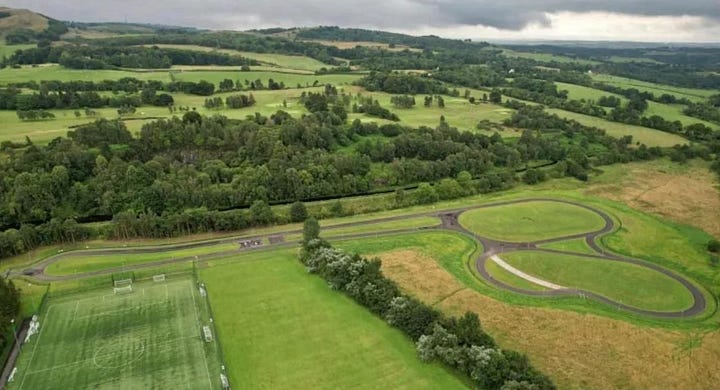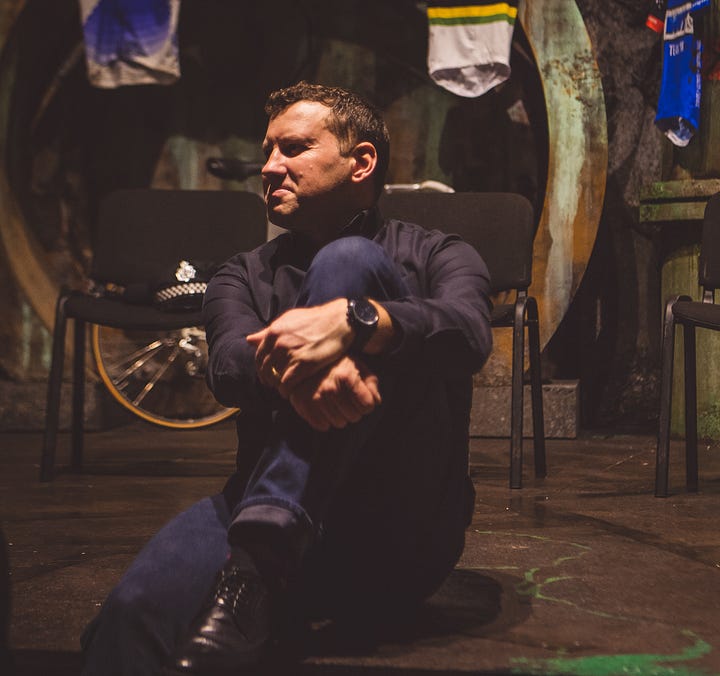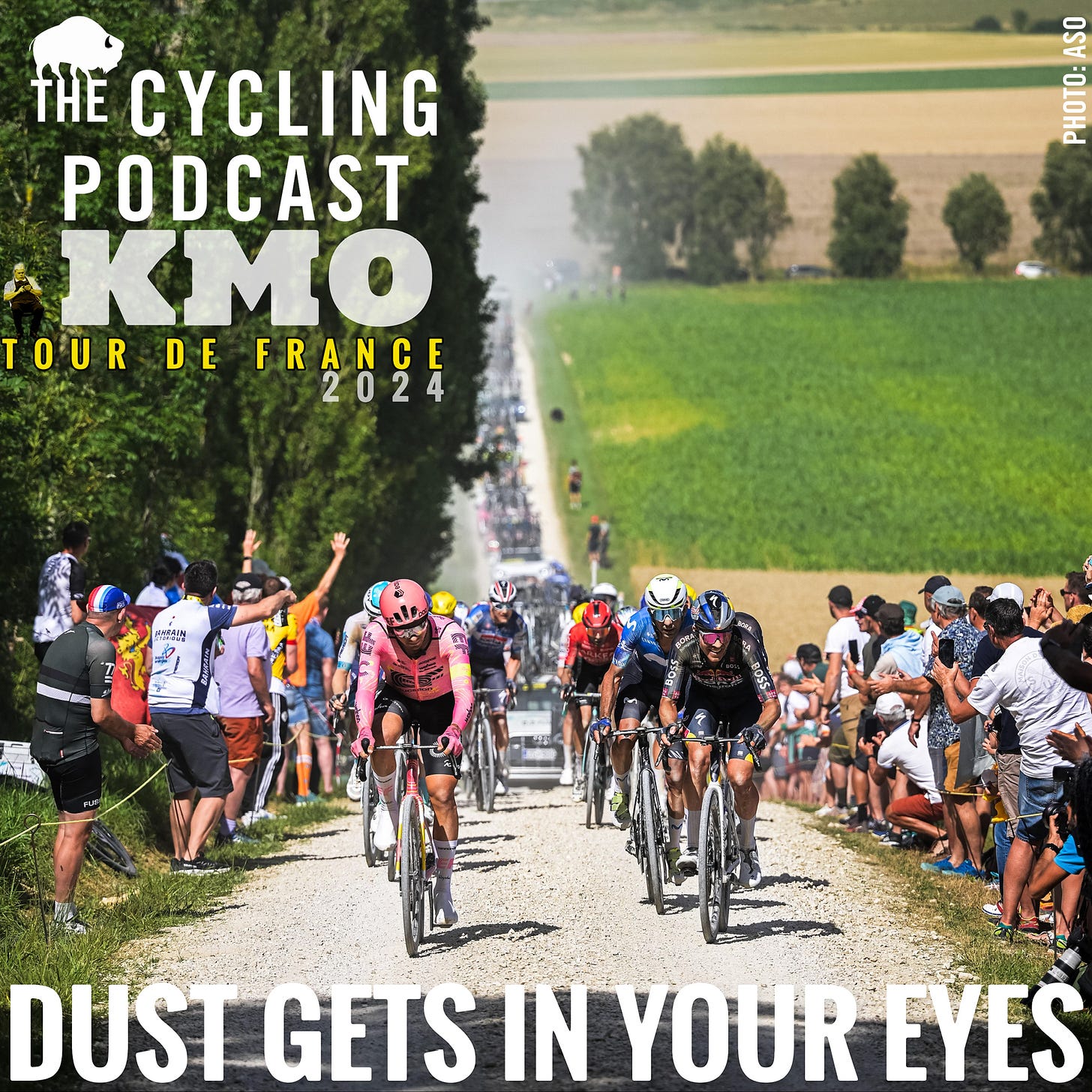Listen to Richard’s interview with Red Bull-Bora-Hansgrohe team doctor Matthias Gebhardt following Aleksandr Vlasov’s crash on Sunday.
by Richard Abraham
To be honest, you probably saw as much of it as I did.
No doubt, you came to the same conclusion.
The Conclusion: this guy can barely stand up without wobbling. He’s just somersaulted into a ditch. He’s probably concussed. Don’t let him get on that bike. Aaarggh, you’re going to put him on that bike, aren’t you? This guy shouldn’t be riding. Jeez… this sport…
Despite being tossed into a ditch like a puppet whose strings had snapped, Aleksandr Vlasov rejoined the group of favourites and finished the remaining 50 kilometres of stage nine. Somehow.
The story was somewhat lost in the madness of the day, but once the dust settled, the incident played on my mind. An image of Vlasov’s crunched up bike did the rounds on social media and on the first rest day, Red Bull-Bora-Hansgrohe announced that their rider had to quit the race with a broken ankle (evidently adrenaline can and had been a powerful drug).
The following day I made a beeline for the Red Bull-Bora-Hansgrohe bus. Recorder off, simply: how is Alex and what went on there?
The team was somewhat frustrated by the backlash on social media, as much as they understood how and why armchair neurologists had determined that they were guilty of jeopardising their rider’s safety by letting him ride on with a possible concussion.
In truth, I was one of them. The reason: we’ve seen stuff like this before. Toms Skujiņš stumbling across the road at the 2017 Tour of California. Romain Bardet in the 2020 Tour. Wobbly riders. Clear signs of concussion. Situations where everybody was lucky that things didn’t end up worse. Watching on, Aleksandr Vlasov’s crash looked like another case to add to the file.
On Tuesday morning I spoke to the Red Bull team doctor, Matthias Gebhardt, and he outlined the story of the day. You can listen to the whole interview with him above – and please do – but in short, to paraphrase: the mechanic got Vlasov going on a new bike, the race doctor assessed Vlasov for concussion on the road, deemed him fit to continue, and so Vlasov did (of course he did: this is the Tour).
Gebhardt was in contact with the race doctor. He then assessed Vlasov himself immediately after the stage and he passed the concussion tests four times (three times after the stage and again the following morning).
It was only as I got in the Cycling Podcar and we made our way to the finish line in Saint-Amand-Montrond that I heard that Geraint Thomas, speaking on his own podcast (you’re welcome Geraint), had said that he’d seen Vlasov vomit on the bike on the way to finish the stage (a clear sign of possible concussion). Ah dammit. Wish I’d put that to them. But so it often goes on the Tour.
Red Bull-Bora-Hansgrohe says that Vlasov did not suffer a concussion. Whether he did or he didn’t is actually almost irrelevant in this scenario: nobody knew Vlasov’s ankle was broken, he looked like he was concussed, and, under a precautionary approach, that should have been enough. The fact remains that the various actors in that scenario – mechanic, race doctor, fellow competitors, team doctor, sports director and Vlasov himself – had allowed an injured rider who could have been concussed to remount his bike and ride back into the race.
Unfortunately concussion is not easy to diagnose. There’s no blood; bones don’t get broken. There are cognitive tests such as the SCAT 5 test (Sport Concussion Assessment Tool Fifth Edition) that Dr Gebhardt refers to in the interview above, and also a simple test to measure the eyeball’s saccades (its rapid micro-movements, which slow down after concussion). But these take time and, short of an MRI scan, the tests boil down to this: do you appear concussed?
If you appear concussed, you probably are.
On Tuesday morning I read through the UCI’s concussion protocol and, if it were down to me – based on my interpretation of those guidelines – Vlasov should not have been allowed to continue. On the TV evidence, he appeared concussed.
Perhaps that’s because I speak as somebody who has endured the effects of concussion. Two big knocks on the old noggin within two months of each other, yet I passed all the immediate concussion tests on both occasions and dealt with the accompanying periods of convalescence from a smashed-up face and a broken collarbone respectively.
But once the immediate trauma of the latter shunt had begun to heal, I was not myself. I don’t need to list all the symptoms of concussion; I had most of them though.
For the first time in my life, I learned that concussion sucks for everybody involved. I also learned that the responsibility of dealing with it shouldn’t be left to anybody with motives other than their own health.
Once my bones were healed, I went hiking in the mountains. Boy it felt good after weeks on the sofa. But after a few hours, the lights went out. I lost all ability to concentrate; it was all I could do to put one foot in front of the other. Before long, I tripped on a tree root, fell, landed hard, cracked a rib, and gave my poor old brain something else to deal with.
So I felt for Vlasov.
This decision, however, is not down to me.
Maybe that’s a good thing. There are plenty of former riders around the paddock whose careers have been ended by concussion and the risks of ignoring it are now well understood. But riders gritting their teeth and battling on to the finish line is an important and attractive part of the sport. In the heat of the moment, when the race rides away into the dusty hills, those risks are evidently still worth taking. And they are being taken.
I don’t propose an immediate solution. Most ideas involve some kind of ‘time-out’ space where an independent professional can properly assess the rider during the stage before deciding if they can continue or not). I just can’t help feeling that what went on with Vlasov on stage nine was not good enough. And it won’t be good enough next time.
This kind of system fails riders. It also fails their competitors, and their colleagues (medical science knows that a second blow soon after the first can often be much, much worse, and who wants to be the mechanic who, with a sports director yelling in their ear, sends a rider off to suffer more severe consequences?). And the current system is failing the whole sport. None of this looks good.
Get well soon Alex Vlasov. I only hope this isn’t one of those things that we in the sport look back on and wish the sport had done more, and done more sooner.
New for Friends of the Podcast
The latest episode exclusively for Friends of the Podcast subscribers takes you to the heart of the Tour’s ninth stage. Richard, Mitch and Graham headed to the Chemins Blancs to witness the gravel stage. Mountains and cobbles are accepted dishes on the Tour’s menu but the question of whether gravel belongs on the route continued until long after the dust had settled. The fact is, though, that the gravel sectors that featured in Sunday’s stage bear more similarity to the roads the riders in the first half of the 20th century raced on than the modern silky smooth surfaces.



Toast the Tour with DVine Cellars
There’s still time to get the case of wines Greg Andrews and the team at DVine Cellars have put together to match the route of the Tour.
The DVine Cellars 2024 Tour case
• Domaine Dupraz En Route Pour l'Apero Jacquère, Savoie, France
or Domaine Bruno Lupin Roussette Frangy, Savoie, France
• Domaine Corsin, Macon-Villages, Burgundy, France
• Domaine du Salvard, Cheverny Rouge, Gamay & Pinot, Loire Valley, France
• Chateau Paillas 2016 Cahors, France
• Bergerie de L'Hortus Blanc Pic St Loup, Languedoc, France
• Chateau de L'Escarelle, Les Deux Anges, Provence, France
Join us for a ride in Richard’s memory


Richard Moore’s dad Brian, and Richard’s two brothers Robin and Peter, would like our listeners – and especially Friends of The Cycling Podcast – to join them at West Lothian cycle circuit in Linlithgow, Scotland, on Saturday, July 20, when Mark Beaumont will unveil a plaque, created by Stacy Snyder, in Richard’s memory.
Bring a bike and join us on a few laps of the circuit, wear your Cycling Podcast jersey or casquette, if you have one. If you can’t bring a bike but just want to say hello and have a cup of tea, refreshments will be available. Brian has even promised the sun will be shining!
Saturday, July 20
West Lothian Cycle Circuit
McGinley Way, Linlithgow EH49 6SQ
Circuit open: 10.00 to 13.00
The plaque will be unveiled at 11.00.
The Cycling Podcast is supported by MAAP
A big thank you to MAAP for supporting The Cycling Podcast. Check out the full range of clothing to make you look the part on, and off, the bike at maap.cc






Great article about Vlasov and concussion diagnoses. And, as a fellow Scot living in Bournemouth, wish I could be in West Lothian on 20th June. My thoughts will be with Richard and his family.